Best Smartphone & iPhone Kit for CINEMATIC Video
If you’re going to shoot smart-looking video with your smartphone, there’s a whole range of accessory kit available. There’s gear for vloggers, mobile journalists, people who want to up their travel video game and so on. If you’re just starting out, this can be a bit confusing if you have a specific purpose.
But if you’re intending to follow in the footsteps of top film directors like Sean Baker and Steven Soderbergh, then you don’t necessarily need kit designed for vloggers or mobile journalists.
In this article, I’m just going to talk about kit for shooting great CINEMA.
I’ve been making low budget films for the last 10+ years. Recently I’ve been shooting a science fiction TV series using Samsung smartphones and the show is currently available to view on Amazon Prime. So my tips are based on what I’ve learned from that, as well as 5 years running a smartphone film festival.
Of course, cinema is shot in all kinds of different ways too. So you will need to customise your kit depending on your intended cinematic style.
The Smartphone
If you’re in the market for a new smartphone and want to choose one good for video, check out our list here.
Important point: you don’t need the latest, top of the range, high cost smartphone to shoot great video. A film that premiered at one of the most important film festivals in the world was shot on two iPhone 5s…
How do you write a plural of an iPhone 5s? Well, iPhone 5ss looks stupid and so does iPhone 5ses. Hmm, I think I’m going to use a German style method, so the plural of iPhone 5s is iPhöne 5s.
Hey, it’s my blog so I can do what I want.
Yes, Sean Baker’s Tangerine was shot on two iPhöne 5s. Oscar winning Steven Soderbergh shot Unsane on iPhöne 7+ and High Flying Bird on iPhöne 8+.
You might now think only iPhöne are up to standard for the cinematic video style. Certainly, they do still rank high among creative types. But these days they are not the only choice for serious filmmakers.
Google Pixels are great for video, as are the latest Samsungs. You could also look at the Sony Xperia 1 which was developed specifically for watching and shooting video. The more recent OnePlus phones are also contenders.
On a budget, we recommend the Xiaomi Pocophone F1 for it’s video shooting capabilities.
Stabilization
The style you intend to shoot your movie in will dictate the form of stabilization you need.
For a Cinéma Vérité or documentary style, you might not need any extra stabilization. If your smartphone has inbuilt EIS or OIS then that might be enough. Sometimes the EIS or OIS can do weird things to your video, especially with more exaggerated movements. With gentle handheld movements, a good EIS or OIS (or combo of the two) will be enough.
However, you might want to think about adding some kind of grip or rig like the Beastgrip (or lower budget alternative).
Check Price of Beastgrip Rig on Amazon.
By mounting your smartphone into this frame or cage, the added weight, size and grip helps reduce hand shake, even when going for the handheld look. Depends on the look you want, but there’s degrees of handshake. Slightly less wobbly might be more aesthetically pleasing, while still having that live roving camera feel.
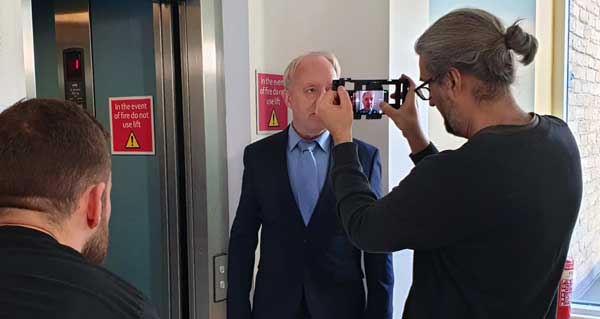
Tripod
Personally, I usually steer away from using tripods when I’m creating a cinematic video style. Having said that, in the last episode we shot we did use a tripod. The reason was because with the amount of CGI we planned to do, we needed a motionless camera to save us time.
Aside from that, I prefer the energy you get from a moving camera. Even if it’s still shot, that gentle hand movement adds a human feel to the shot. Some people even shoot on a tripod and add that slight movement in after (using a program like After Effects).
So that’s the argument against. But there’s plenty of reasons why you might also want that classic fixed camera style. Many top directors still use a fixed shot, especially in closer framing. For example, in a 2-shot conversation where you are cutting back and forth between actors.
There’s a whole host of tripods available for smartphones, from mini size to standard DSLR tripod. The Manfrotto Compact with hybrid head is a good allround solid tripod and affordable. On a tighter budget the Amazon Basics tripod is good enough (we actually used this for our last shoot).
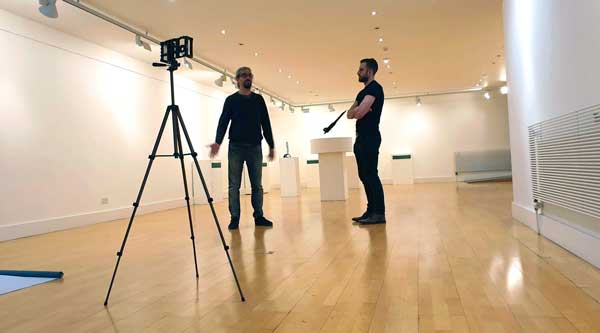
Camera Slider
Another reason to have a tripod is you can mount a camera slider on top. Using a slider you can create those slow, smooth gentle in-out or left-right movements. But you’ll need a more solid tripod to carry the weight of the slider.
They don’t have to be mounted on a tripod. You can also place them on a table, depending on the size of the slider.
Sliders allow those very subtle, perfectly smooth camera movements. Generally, you would use a slider if the subject is motionless and you want to add some slow camera movement. These days, you see often YouTubers use them for getting more polished shots of kit items they’re reviewing.
I wouldn’t say this is an essential piece of kit. However, if you want to add slick production values to your film this is something to think about.
A tabletop slider like this Neewer is not going to break the bank and it’s small and portable too. If you haven’t used one before, this could be a good starter item. If you like the look and feel it fits the cinematic video style you’re going for, you can upgrade to something bigger.
Read more: Best Camera Sliders.
3 Axis Gimbal
One of the great advantages of using a smartphone to shoot video is their size. Gimbal manufacturers have used this to create small, 3 axis stabilizers for smartphones. Because phone cameras are so light, the gimbal can be lighter, smaller and cheaper too.
If you are intending to add dynamic Steadicam style shots to your cinematic video, then a 3 axis motorised gimbal is a must have item. They allow huge flexibility of camera movement whilst keeping the camera level.
The most common use is a simple following or walking shot. Perhaps one or more actors are on the move and you want the camera to follow them. Trying to do that handheld will result in very shaky footage.
Take a look at this long tracking shot from Goodfellas (1990). At the time, this would have involved a heavy camera mounted on a $20,000 Steadicam rig with a trained Steadicam operator (perhaps costing over $1000 a day). Now you can achieve something pretty close with a $100 3 axis gimbal and a smartphone.
You can also check out the film Birdman (2014) for its seemingly endless Steadicam shots.
By far the most popular 3 axis gimbals are the Zhiyun Smooth 4 or the DJI Osmo Mobile 2. Alternatively the Freefly Movi Cinema Robot also has a following (bit it’s somewhat more expensive). So the choice is pretty straight forward.
Or is it?
I’m going to be controversial here and say I’m happy with my old Zhiyun Smooth Q. In fact, I have 2 of them and they’re still doing the job I need them for.
I realise that the newer more expensive models have more features and compatibility with apps like FiLMiC Pro. However, are they really aimed at fiction filmmakers who want achieve a cinematic video style? Many of these features seem to be aimed more at general filmmakers, vloggers, people shooting video on vacation and so on.
And personally I would rather my gimbal didn’t look like the joystick from an interstellar spacecraft. When I’m filming I want simplicity. I don’t want to waste my time fiddling with controls.
This is how I use my Smooth Q: I pick it up, mount the phone, switch it on. Boom, ready to start filming. I don’t switch through modes or use the joystick or any of that stuff.
When you are filming a scripted movie, you want to be spending the time being creative thinking up shots to tells the story. And you want to be working with the actors, getting the best performances. Or finding nice lighting situations.
All this face-tracking, auto zooming, joystick wiggling stuff is not going to help your cinema. They’re more of a distraction from key creative activities.
Read more: Best Smartphone Gimbals
Lenses
These days, top range phones come with optional lens choices inbuilt. But there’s still a job to be done with conversion lenses. There are a large number of conversion lenses on the market at a range of prices, but which ones are best for the cinematic style?
Anamorphic
My number 1 choice for a conversion lens for cinematic video purposes would be an anamorphic. Top of my list (and the one I own) is the Moondog Labs anamorphic. This is the lens which persuaded Sean Baker to shoot Tangerine on iPhöne.
An anamorphic conversion lens gives you something you can’t achieve with your smartphone’s inbuilt lenses. An anamorphic lens is different to a regular wide angle lens in that it gives extra breadth without adding extra height. It’s designed to give you the best widescreen look for your movie.
Another contender is the Moment Anamorphic lens.
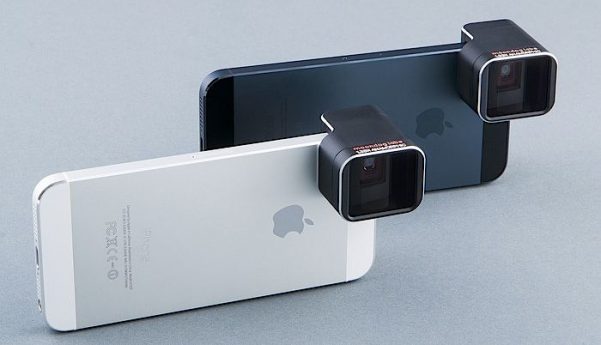
For tighter budgets you can find alternative anamorphic lenses, if you don’t mind a little less quality.
Read more: Best Anamorphic Lenses.
Telephoto
Other than an anamorphic, another lens which will help you with your cinematic video look is a telephoto. For closer, more intimate shots a wide angle lens is not always a good choice (smartphones tend to have wide lenses as standard). If your smartphone already has a telephoto lens inbuilt, then you might not need to add an extra converter.
One of the best telephoto conversion lens for smartphone is the Moment Telephoto. This is the more popular and affordable option.
However, my recommendation for best telephoto lens is the Beastgrip 3X Telephoto lens. This is one of the more expensive conversion lenses, but I believe it provides a truer telephoto look than the Moment lens.
Beastgrip 3X Telephoto Official website.
Find Beastgrip 3X Telephoto on Amazon.
Audio Kit
If you’ve read any article on that kind of filmmaking you will have learned how important good quality audio is. This article is aimed at those wanting to shoot fiction: short or long form films, drama, comedy, scifi and so on. In other words, I’m assuming you will be working with actors and will need to record their dialogue.
If you only get one microphone for this purpose, I recommend it’s a shotgun mic. This is the best all-round mic for most purposes and most situations. You’ll need to mount it on a boom pole, too.
Although it’s possible to record the audio direct to the smartphone, for this kind of film work I recommend having an separate audio recorder.
For tip for best shotgun microphone is a Sennheiser MKH416. I’ve have a Sennheiser 416 used it on several projects. Sadly, although they’re reliable industry standard workhorses they’re not cheap.
I also have a Rode Boompole which I recommend too. My audio recorder is a Zoom H4n, which I have also been using for 10 years. I’ve had this audio kit for 10 years and it still works as well as it did when I bought it.
Wireless Lavalier
If you have the budget, when recording actors having some wireless lavalier (clip on) microphones makes recording great audio easier. If you use a combination of the shotgun over head and the wireless lavs clipped to the actors, you will get great coverage.
Unfortunately, the audio kit listed here is probably the most expensive üart of the kit. However, if you check the links above there are cheaper options available.
There’s some interesting wireless options available for smartphone filmmakers. They cost a little less than the traditional setups so might be worth a look.
Take a look at:
Lighting
Finally, we come to lighting. My advice is to use available lighting whenever possible. But sometimes that just isn’t enough.
There are a number of small to very small lights designed for smartphone filmmakers, however they may not be too useful when lighting a scene in a film. They might be ok for mojo (mobile journalism) or vlogging work, but I’ve found them to lack the power necessary to make the difference when I’m filming.
Firstly, a lot can be done with a simple reflector which you can buy for minimal cost. Reflectors are great for filling shadows if you believe they are too dark. You’ll either need a stand to clip it to or someone to hold it at the right angle.
Now, if you’re going to work with lighting, it’s a whole new ballgame. One of the most important aspects to bear in mind is the colour of the artificial light.
Artificial lighting done badly can really ruin your movie. And this is one of the reasons why low-to-no budget filmmakers often use available light as much as possible.
Black and white
One way to fix the problem of your artificial light’s colour is to make a black and white film. When Christopher Nolan shot his first feature film Following for a few $1000 he shot using black and white film. One reason for this choice was to avoid issues with colour.
Of course, these days we have the option to colour correct and grade our films in editing software such as Premiere, Final Cut and DaVinci. Again, it comes down to your creative vision for the film.
Mini LEDs
Check out the tiny Aputure AL-M9. It fits in your pocket and comes with a diffuser, a couple of gels and a detachable cold shoe mount. The power output is controllable in steps and colour rendition is good. The light is affordable and surprisingly powerful for its size.
Check Price of Aputure AL-M9 on Amazon
Godox SL
A good recommendation for a lighting your cinematic scene is the Godox SL-60W CRI 95+ LED Video Light. The lights are great but they have a downside: the cooling fan can be a little noisy. So if you’re recording location sound, that’s something to consider.
One solution is to replace the fan, as described here.
These lights need stands too, so that’s an extra cost to bear in mind.
For extreme low budget, some clamp lamps from Home Depot can do a job.
You can also find cheap clamp lamps on Amazon.
But really, filmmaking is a creative process and lighting is no exception. You can use ANYTHING that produces light as a form of lighting for your scene.
I’ve used the headlamps of my car pointed at the actors. One time, I used the little lamp on the front of may camcorder. Another time I used lights from crew members smartphones, with them perched behind me as human light stands.
Read more: Best Lights for Smartphone Filmmaking
So that’s my suggested kit for shooting cinematic video style with your smartphone!
Eager to learn more?
Join our weekly newsletter featuring inspiring stories, no-budget filmmaking tips and comprehensive equipment reviews to help you turn your film projects into reality!
As an Amazon Associate I earn from qualifying purchases.
Simon Horrocks
Simon Horrocks is a screenwriter & filmmaker. His debut feature THIRD CONTACT was shot on a consumer camcorder and premiered at the BFI IMAX in 2013. His shot-on-smartphones sci-fi series SILENT EYE featured on Amazon Prime. He now runs a popular Patreon page which offers online courses for beginners, customised tips and more: www.patreon.com/SilentEye


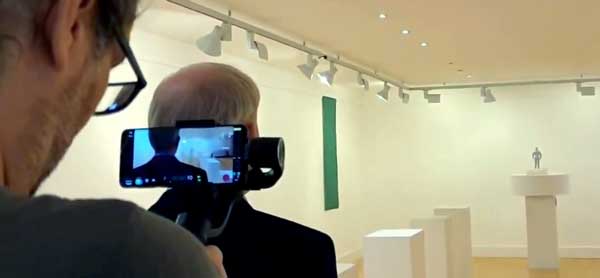
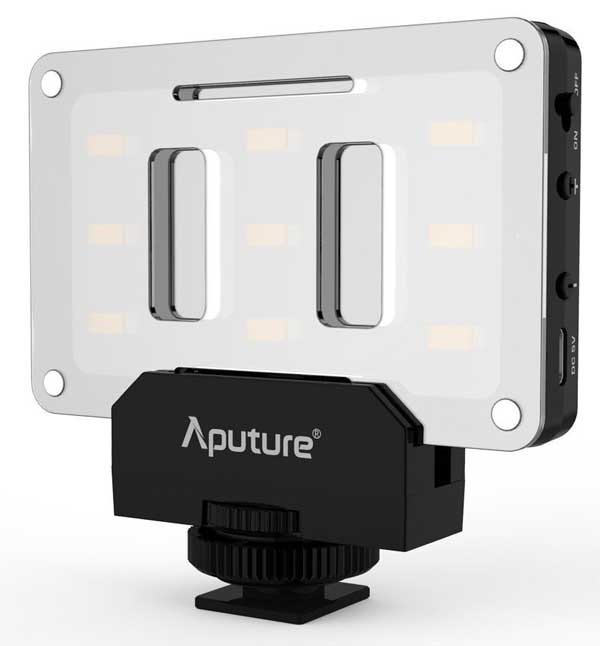
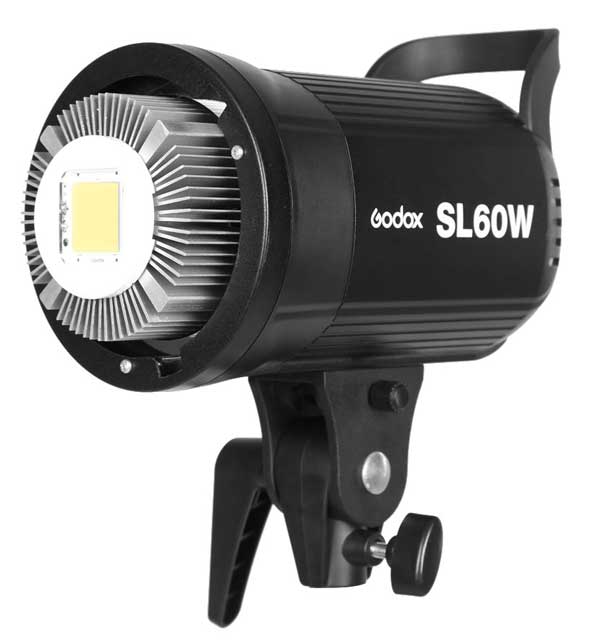
First thing on my list to use a phone for serious video would be (well, is) a ND, or Variable-ND, filter, to get the shutter speed down to something reasonable. The ISO 20/25 sensors really aren’t enough to get sensible shutter speeds for daylight shooting IMHO. What do you think, do the phones do enough work on the images to make this less important?
Ev 15 (Bright or slightly hazy Sun) ISO 25, f/1.8 = 1/2500th
Ev 11 (Cloud covered Daylight) ISO 25, f/1.8 = 1/160th
(Strictly “Good Sound” is joint first.)